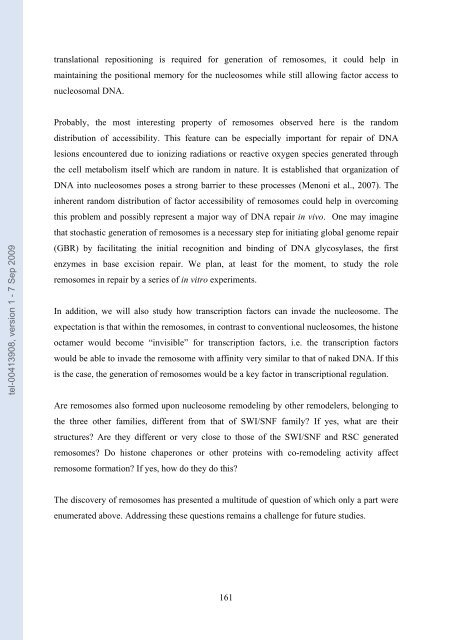Etudes sur le mécanisme de remodelage des nucléosomes par ...
Etudes sur le mécanisme de remodelage des nucléosomes par ...
Etudes sur le mécanisme de remodelage des nucléosomes par ...
You also want an ePaper? Increase the reach of your titles
YUMPU automatically turns print PDFs into web optimized ePapers that Google loves.
tel-00413908, version 1 - 7 Sep 2009<br />
translational repositioning is required for generation of remosomes, it could help in<br />
maintaining the positional memory for the nuc<strong>le</strong>osomes whi<strong>le</strong> still allowing factor access to<br />
nuc<strong>le</strong>osomal DNA.<br />
Probably, the most interesting property of remosomes observed here is the random<br />
distribution of accessibility. This feature can be especially important for repair of DNA<br />
<strong>le</strong>sions encountered due to ionizing radiations or reactive oxygen species generated through<br />
the cell metabolism itself which are random in nature. It is established that organization of<br />
DNA into nuc<strong>le</strong>osomes poses a strong barrier to these processes (Menoni et al., 2007). The<br />
inherent random distribution of factor accessibility of remosomes could help in overcoming<br />
this prob<strong>le</strong>m and possibly represent a major way of DNA repair in vivo. One may imagine<br />
that stochastic generation of remosomes is a necessary step for initiating global genome repair<br />
(GBR) by facilitating the initial recognition and binding of DNA glycosylases, the first<br />
enzymes in base excision repair. We plan, at <strong>le</strong>ast for the moment, to study the ro<strong>le</strong><br />
remosomes in repair by a series of in vitro experiments.<br />
In addition, we will also study how transcription factors can inva<strong>de</strong> the nuc<strong>le</strong>osome. The<br />
expectation is that within the remosomes, in contrast to conventional nuc<strong>le</strong>osomes, the histone<br />
octamer would become “invisib<strong>le</strong>” for transcription factors, i.e. the transcription factors<br />
would be ab<strong>le</strong> to inva<strong>de</strong> the remosome with affinity very similar to that of naked DNA. If this<br />
is the case, the generation of remosomes would be a key factor in transcriptional regulation.<br />
Are remosomes also formed upon nuc<strong>le</strong>osome remo<strong>de</strong>ling by other remo<strong>de</strong><strong>le</strong>rs, belonging to<br />
the three other families, different from that of SWI/SNF family? If yes, what are their<br />
structures? Are they different or very close to those of the SWI/SNF and RSC generated<br />
remosomes? Do histone chaperones or other proteins with co-remo<strong>de</strong>ling activity affect<br />
remosome formation? If yes, how do they do this?<br />
The discovery of remosomes has presented a multitu<strong>de</strong> of question of which only a <strong>par</strong>t were<br />
enumerated above. Addressing these questions remains a chal<strong>le</strong>nge for future studies.<br />
161

















